Table of Contents
Pulp-body-concentration Processes
The Potter and Delprat processes
Now combined and known by the name Potter-Delprat process, are described in U. S. patents 735,071, 763,662, 768,035 and 776,145. As at present practiced the dewatered pulp is fed into an apparatus of the type shown in Fig. 27, which is from 10 to 20 ft. deep. Hot sulphuric acid solution of 2 to 3 per cent, strength or acid salt cake solution of 1.3 to 1.4 density is introduced through the pipes shown to the bottom of the vat. A layer of solids two feet or more in thickness, depending upon the depth of the vat, is maintained in teeter above the spigot. Gas is precipitated as bubbles onto the sulphides and the bubbles rise to the surface with a load of sulphide, forming there a coherent froth which overflows as shown. The tailing is drawn off as a thickened product from the spigot at the bottom of the box. The compartment without a spigot is for the purpose of collecting any coarse particles which would tend to clog the spigot. This process has been used for years in the treatment of large tonnages of sphalerite ores in Australia and has made good recoveries in the form of high-grade concentrates. In ores containing carbonates, as do most of the Broken Hill ores where these processes were invented and practiced, it is probable that most of the effective gas is carbon dioxide. Air and water vapor will, however, precipitate in sufficient quantity, under the conditions of the practice of the combined processes, to effectively raise the sulphide in the form of a coherent froth.
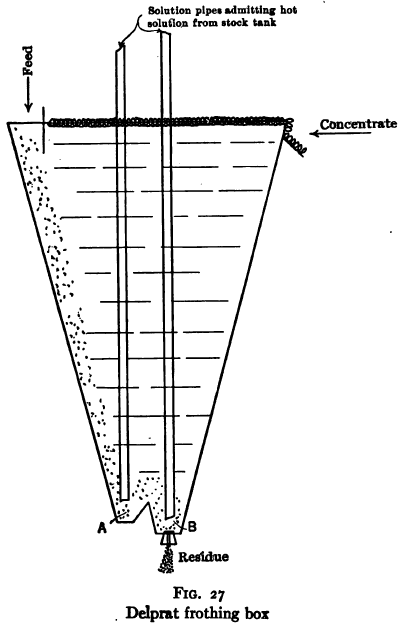
The Froment process
This was discovered in 1902 and patented in Italy and England but not in the United States. The steps of the process, as described by the inventor, are essentially as follows: two and one half parts of ore with six parts of water and from 1 to 2 per cent, of limestone are introduced into a mixer with an amount of oil ranging from 1 to 1 1/2 per cent, on the ore and stirred thoroughly to disperse the oil through the pulp. The mixture is then run into a second vat fitted with a slow moving rake at the bottom and sulphuric acid sufficient to react with the limestone is slowly added through a perforated coil. The sulphides rise to the surface in the form of a heavy matted froth and may be skimmed off. As in all other flotation processes the ore must be finely ground.
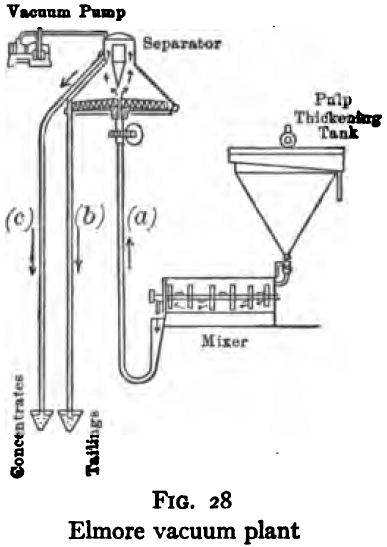
The Elmore vacuum process
As described in U. S. patent 826,411, is practiced in a plant such as is shown in Fig. 28. Pulp ground to at least 0.5-mm. maximum size and containing about 50 per cent, solids is mixed with oil in an amount less than 0.5 per cent, on the ore, with or without a correspondingly small amount of acid, in a mixer and from thence discharged into the feed pipe (a) of the separating apparatus. Here water is added to bring the pulp to a consistency of 15 to 25 per cent, solids. The separating apparatus consists of a closed conical chamber fitted with a slowly revolving rake at the bottom, a tailing discharge pipe (b) at the periphery and a concentrate discharge pipe (c) from near the apex. The separating chamber is attached to a vacuum pump. The lower end of the pipes (b) and (c) is sealed by causing them to discharge below the surface of liquid in tanks as shown. The vertical lift in the pipe (a) is about 25 ft. The vertical length of the pipes (b) and (c) is somewhat over 30 ft. A vacuum of 25 to 27 in. of mercury is maintained. Under the influence of this vacuum the pulp fed into the pipe (a) passes up into the separating chamber. Here air comes out of solution at the surfaces of the sulphides and raises them through the liquid in the separator to the apex of the same where they overflow into an annular launder and pass down the pipe (c). At the same time the tailing is slowly scraped by the rakes to the periphery of the floor where it passes down the tailing-discharge pipe (b). The rate of flow in pipes (a) and (b) is so regulated that the pulp level is maintained slightly below the overflow lip in the apex of the separator. The capacity of a 5-ft. separator is from 25 to 50 tons of ore per day. No retreatment of the concentrate is necessary. The power consumption per pan is small, being well under 5 h.p. for mixer and vacuum pump together. The development of the vacuum process was stopped by the introduction of the agitation-froth process but it is probable that if the same amount of work had been expended in attempts to make the vacuum process a highly efficient operation, as was spent on bringing the agitation-froth process to its present degree of efficiency, the result would have been equally favorable.
Agitation-froth flotation
Agitation-froth flotation is practiced in several varieties of machines. The most widely used are the Janney mechanical and the Minerals Separation.
The Janney machine
As it is shown in Fig. 29. It consists essentially of an agitating compartment (a) with two froth-separating compartments (b). In the usual and best form the agitator shaft is mounted as an extension of the spindle of a 10-h.p. vertical motor as shown. The agitator shaft carries two fourarmed impellers with blades set at 45 degrees. The agitating compartment is circular and contains four baffles (c) extending slightly more than one-half the distance from the bottom toward the top. The arms of the lower impeller are shorter than those of the upper in order to clear these baffles. Feed is introduced through the side of the compartment, near the bottom, by means of a pipe; is thrown out through the channels at the top, on each side of the agitator compartment, and is introduced, by means of the submersion blades (d) slightly below the level of the pulp in the froth-separating compartments. In general, several machines are installed in series. Outline arrangements of two such installations are shown in Figs. 30 and 31. In the arrangement shown in Fig. 29 the tailing leaving the first compartment, passes through an opening (e) regulated by means of the valve (f) into the froth-separating compartment in the succeeding machine. The froth-separating compartments are divided to within about a foot of the overflow lip by means of a wall (g). From the bottom of the two compartments thus formed, pipes (h) lead back to the agitating compartment. Pulp, entering the first or upper of these two sub-divisions in a given froth-separating compartment, is drawn upward into the agitating compartment, thrown over the top of the same into the froth-separating compartment and falls back, a part on each side of the divider (g). Practically all of that which falls back on the upper side of the divider is again drawn up through the pipe from that compartment into the agitating compartment. A part of that which falls on the down-stream side of the divider (g) is also drawn back into the agitating compartment. Thus a part of the pulp is circulated in each machine and subjected to agitation and aeration more times than would be the case if the flow were alternately through agitating and froth-separating compartments. Froth is skimmed by means of the eccentrically driven unloader (j) which is operated by means of a small independent motor (k), Fig. 30. The series of machines is ordinarily preceded by one, two, or three agitating compartments built without froth-separating compartments. These are called “emulsifiers.” Flotation agents are added to the pulp entering the emulsifiers. Additional flotation agents are added, if necessary, through the oil funnel (m) and pass through the oil pipe (n) into circulating pipes (h). The multiple arrangement of feed shown in Fig. 31 is ordinarily used where it is desired to make a finished concentrate on the early cells and to circulate the froth from the later cells back to the head of the series. The series arrangement shown in Fig. 30 is used where the froth taken from the various froth-separating compartments is cleaned on other machines.
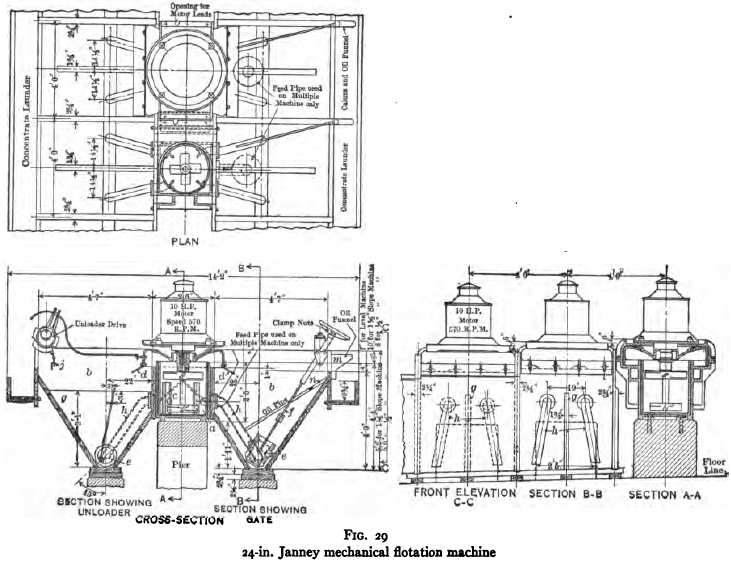
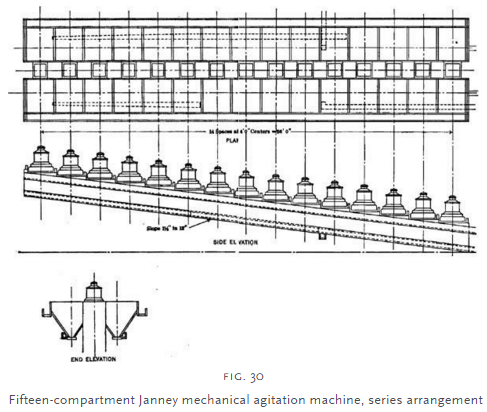
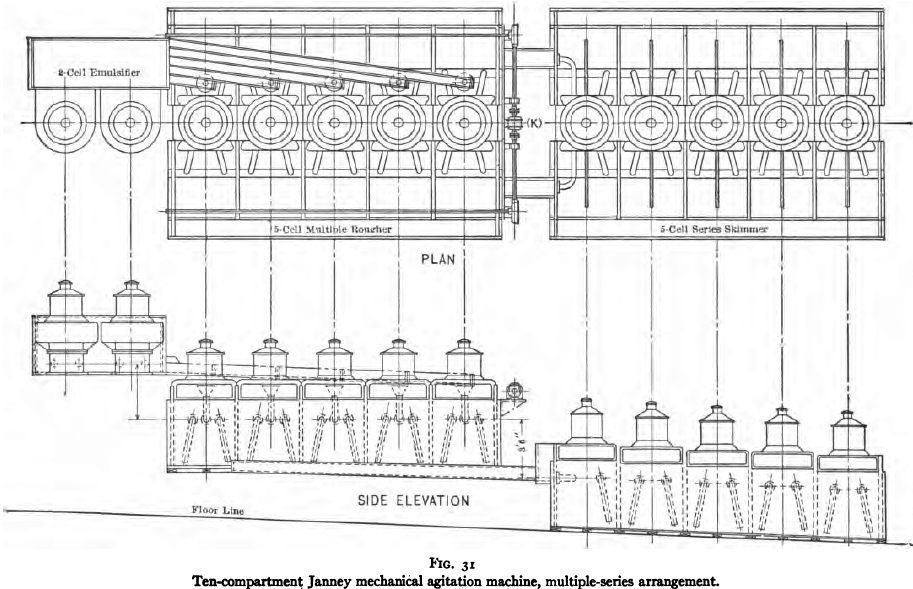
From five to fifteen agitators, each with two froth-separating boxes and preceded by one or two emulsifiers, comprise a unit. The size of a unit is indicated by the diameter of the agitation chamber and the number of single machines in series. A 24-inch, 16-compartment unit consists of one or two 24-inch emulsifiers followed by 16 agitating compartments with cross-armed impellers, the upper 20 inches and the lower 14 1/2 inches tip to tip, respectively, with 32 froth-separating boxes. The capacity of such a machine depends upon the percentage of solids in the pulp, the number and diameter of impellers, and the character of the ore. On a silicious sandy copper ore in pulps carrying from 10 to 28 per cent. solids, a 13-compartment, 24-inch machine has a capacity of from 150 to 550 tons per 24 hours, the relation between tonnage and percentage of solids being represented by a straight line. Decrease in the number of cells in series will mean a corresponding and almost proportionate decrease in capacity, if the same grade of concentrate and percentage of recovery are to be maintained. There will also be a decrease in capacity if a slimy feed replaces a sandy feed. This is due principally to the fact that such a feed must be treated in a pulp containing a lower percentage of solids and that consequently the bulk to be passed through the machine for a given tonnage of solid is increased. The decrease in capacity is about in proportion to such increase in bulk. The power consumption of a 24-in. machine is approximately 10 h.p. per agitator. The machine is usually run at a peripheral speed of 3600 ft. per minute.
A Minerals Separation machine
The machine, shown in Fig. 32, is installed as shown in the figure with agitators and froth-separating boxes on the same level. The machine consists essentially of the agitating compartment (a) and froth-separating compartment (b). The agitator, which is of the four-armed cross type, with blades set at 45 degrees, is placed close to the bottom of the agitating compartment and is carried on a vertical spindle (c), driven through enclosed bevel gears from a horizontal line shaft. Feed pulp is introduced into the first agitating compartment, or is first passed through one or more agitating compartments without froth-separating boxes, corresponding to the emulsifiers of the Janney machine. The pulp, after agitation and aeration, is thrown out through the slot (d) into the froth-separating compartment, entering at a point about six inches below the pulp level. The tailing from the froth- separating compartment passes through the pipe (e) into the bottom of the next agitating compartment under the influence of the pumping effect of the agitator therein. The rate of flow is regulated by means of the valve (f) actuated by the hand wheel (g) and rod (h). Froth is removed by means of the revolving scraper (j). From 6 to 20 agitating compartments in series, each with one froth-separating compartment, comprise a unit. The size of a unit is indicated by the distance tip to tip of the impeller blades and the number of compartments in series. The usual impeller sizes are 12-inch, 18-inch, and 24-inch. These machines have rated capacities of 50 tons, 300 tons and 600 tons respectively per 24 hours on silicious ores in pulps containing 25 per cent, solids. Actual capacities are about 2, 12, and 25 tons per cell per 24 hours on such a pulp, with a diminution in capacity with decrease in percentage of solids about proportional to the increase in volume of pulp. The power consumption per agitator is two to three h.p., three to five h.p., and six to nine h.p., for the three sizes respectively, depending upon the speed of the impeller and the tonnage of pulp passed through. The usual peripheral speed is from 1500 to 1800 ft. per minute.

Bubble-column Machines
Machines which perform the operation of concentration in a column of bubbles above the surface of the pulp are of three general types: (1) the pneumatic type in which air is released in the pulp through a porous medium; (2) the centrifugal type in which air is drawn into the pulp by centrifugal force; and (3) the cascade or plunging-stream type, in which the air is carried into the pulp by the action of a stream of pulp falling into a body of pulp.
Pneumatic-type bubble-column machines
This machine introduces air into flotation pulps through a porous medium, which, in all present day machines, constitutes the bottom of a box or launder containing the pulp. Usually the flotation agents are pre-mixed with the feed pulp in some other machine. The best known types are the Callow cell, which was the pioneer in so far as operating mill installations are concerned, and the Inspiration type, which was developed from the Callow cell for the purpose of handling larger tonnages with a smaller amount of floor space per ton of solid handled.
The Callow cell
The Callow cell is shown in the usual form in Fig. 33. It consists of a rectangular box (a) with sloping porous bottom (b). The usual dimensions of the box are 8 to 9 ft. long, 2 ft. to 2 ft. 6 in. wide, about 18 in. deep at the feed end and 4 ft. deep at the tailing-discharge end. The porous bottom consists of three or four layers of medium weight canvas or palma twill, supported on a screen or grid on top of an air box. The usual cell has an air box divided into eight compartments, each with an independent connection to a header, the purpose being to allow independent regulation of the air pressure on the under side of the blanket at different points in the length of the cell, in order to balance the different hydrostatic heads at different points along the cell and prevent eddy currents due to unequal air distribution. Pulp is fed into the cell behind the baffle (c), froth overflows the sides, and tailing is discharged through the pipe (d). The rate of discharge is regulated by means of the adjustable float valve (e). The capacity of a single unit such as illustrated is from 35 to 80 tons per 24 hours, the lower figure corresponding to a slimy ore in a pulp containing a low percentage of solids, the higher figure corresponding to a silicious, rather sandy ore in a pulp containing in the neighborhood of 25 per cent, solids. The air consumption is decidedly variable, ranging in different plants from about 6 to about 12 cu. ft. of free air per min. per sq. ft. of porous bottom, at pressures of from three to five pounds per square inch on the supply side of the regulating valves. A good average figure is probably in the neighborhood of 9 cu. ft. per min. per sq. ft. of porous bottom. This air requirement corresponds to a power consumption of between three and one-half and four h.p. per cell. Callow cells are usually run in parallel. General experience is to the effect that, whether run in parallel or in series, the capacity per square foot of porous bottom, in machines producing concentrate of the same grade and recovering approximately the same amount of mineral, is the same irrespective of the method of operation. A modified form of Callow cell designed to economize floor space is shown in Fig. 34. It consists of a rectangular box about 20 ft. long, 7 ft. wide and an average depth of 3 ft., set on a slope of about 2 in. per foot. The box is divided into eight compartments, 3 ft. 5 in. wide by 4 ft. 6 in. long, by means of a central longitudinal wall which extends to the bottom of the box, and three transverse walls. The first and third transverse walls extend to within 5 or 6 in. of the bottom of the box, the second or center wall is so arranged as to cause the pulp to overflow a weir in passing from the second to the third compartment on both sides of the cell. The purpose of this weir is to maintain the desired pulp level in the first two compartments on each side. Practically the partitions serve to divide the box into four cells. Air baskets consisting of shallow boxes with a porous top, of such size that they fit loosely into a compartment, are placed with the porous side up in the bottom of the compartment. The capacity of one of these machines is between 400 and 500 tons per 24 hours on a silicious ore in a pulp containing from 20 to 25 per cent, solids. Air consumption, and consequently power consumption, per square foot of porous bottom are about the same as for the smaller Callow cell.
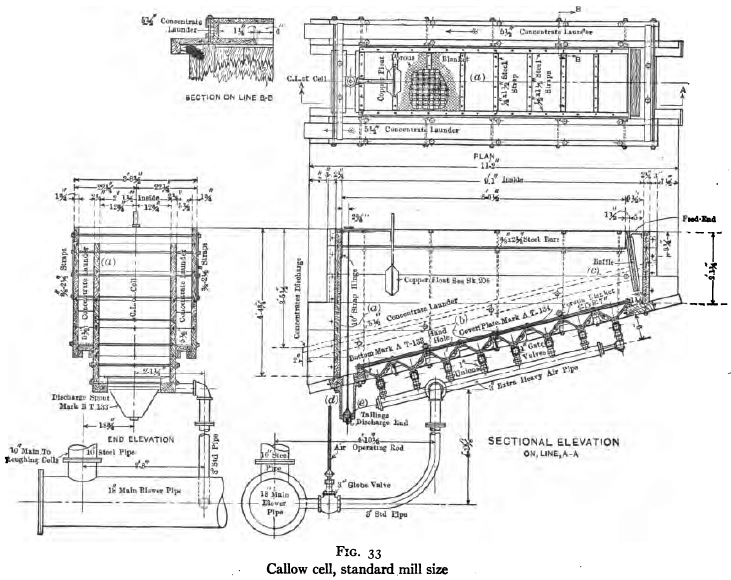
The Inspiration machine
The Inspiration machine is shown in Figs. 35 and 36. It consists essentially of a launder about 3 ft. wide and 4 ft. 6 in. deep, with a slope of about 1/2 in. per foot. It is provided with a removable segmented porous bottom and is divided into compartments by partitions spaced about 3 ft. center to center along its length. The usual number of compartments in a roughing machine ranges from 15 to 20. The compartments are provided with slots about 4 ft. wide and 6 to 8 in. high, cut about 3 in. above the bottom of the launder. The size of the opening between compartments is regulated by gates suspended by a threaded rod from a hand wheel and lug on timbers placed across the top of the launder. Air baskets consisting of shallow boxes of such dimensions that they make a loose fit in a compartment and with the air supply pipe coming down from the top, are placed in the bottom of the launder. In general, two such launders set side by side with a common central froth launder constitute a roughing unit. The rougher froth is cleaned in a similar smaller machine, fed by gravity from the rougher machine. The capacity of such a double unit with 16 rougher compartments each side and six cleaner compartments each side, is from 600 to 1200 tons per 24 hours, the lower figure on a slimy low-grade copper ore in a pulp containing 12 to 15 per cent. solids, the higher figure on a silicious, rather sandy low-grade copper ore in a pulp containing 20 to 25 per cent, solids. Air consumption is from 10 to 12 cu. ft. per sq. ft. of blanket surface, at from 4 to 5 lb. pressure on the supply side of the regulating valves. This means a power consumption of from 0.3 to 0.35 h.p. per sq. ft. of blanket.
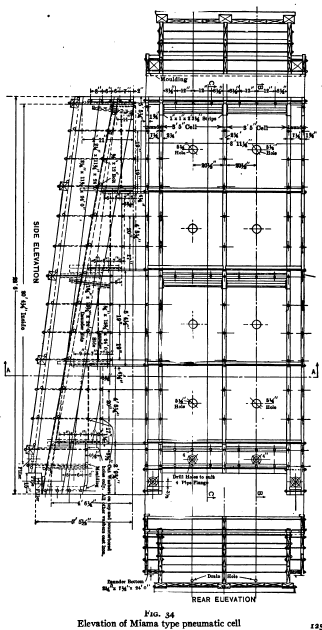
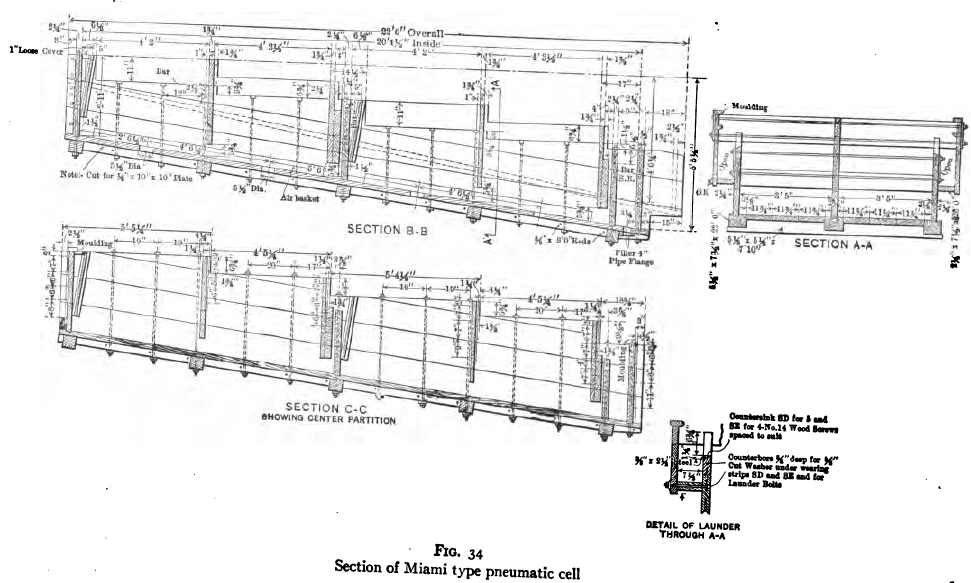
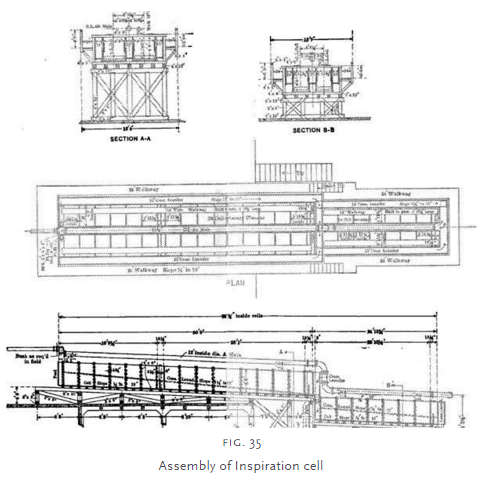
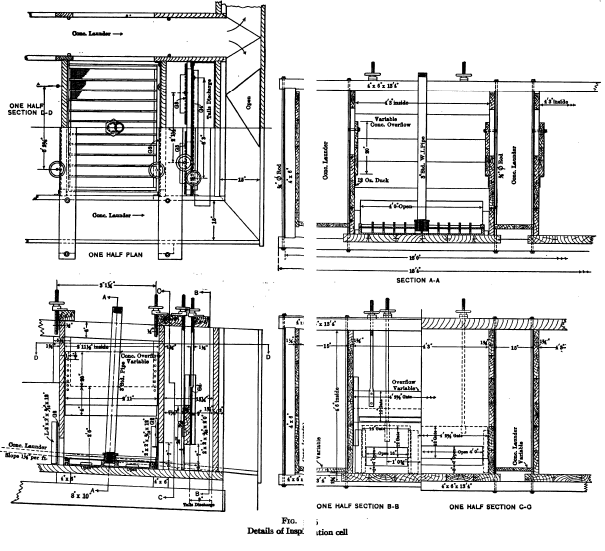
The last word has not yet been said on the construction of porous bottom machines. The steep slope of the bottom in the original Callow cell and the compartmenting in the modified Callow cell and in the Inspiration cell described, were for the purpose principally of preventing sanding and consequent clogging of the porous bottoms. Machines are, however, in operation in which the box is some 20 ft. long and 6 ft. wide, with the bottom nearly horizontal, and it is reported that no serious sanding-up occurs.
In many mills brick, concrete and other materials for porous bottoms have been largely experimented with. Concrete has given satisfactory service and has been adopted in several plants. Special concrete mixtures are used and considerable skill and care in the mixing and aging are necessary, but the life of the bottoms pays for the additional expense of installation. The method of making concrete bottoms at the Ray Consolidated Copper Co. is described by H. C. McCrae in Engineering and Mining Journal, April 10, 1920, as follows:
“The cells used have inside dimensions of 35 1/2 × 51 1/2 in. Two methods of installing the mats have been successfully employed by the company. The first was to construct the porous mat in place, according to the following directions:
“Build the forms in each cell of the machine so as to give a wall of ordinary dense concrete 4 in. wide and 8 in. deep. When the concrete is set, remove the forms and pour the floor of the cell with the same dense concrete to a depth of 4 in. Round pebbles varying in size from 1 1/2 in. to 2 1/2 in. are now placed in the floor of the cell to a depth of approximately 4 in., and the top is covered with small pebbles about 1/2 in. in diameter to obtain a level surface. This pebble filling not only serves as a good foundation upon which to build the overlying porous mat, but also allows sufficient space to equalize the air pressure.
“The proper size of sand for use in making the air mats can be secured from the fine-crushing department of the ordinary concentrator. The sand should be as free as possible from in-closed mineral; therefore, tables treating a sand product that passes 10 mesh, with very little fines, reject tailings suitable for these mats. A hard silicious sand that contains a considerable amount of quartz is preferable. Such sand is generally of irregular fracture, and is much better suited for this purpose than the sand from soft ores or the ordinary rounded river sand. The sand is dried for screening.
“An 18-mesh copper-wire window screen placed and shaken on a horizontal plane is first used. The undersize from this screening is now passed over a screen of the same size placed at a 45-degree angle. This will remove the fines and give a clean sand of uniform size. Five parts of this sized and dry sand are thoroughly mixed with one part of dry Portland cement. This mixture is now dampened by sprinkling on water with a brush. Care should be taken only to dampen and not to add excess water, as the problem is to get the cement to adhere to the sand and dampened sufficiently to make the mass harden. Re- enforcing is put in the dense concrete sides, and 1/4-in. or 3/8-in. iron rods, placed about 6 in. apart each way, are used in the top porous mat for re- enforcing.
“The mixture for the porous mat should now be spread over the bed of pebbles in the cell to a depth of about 3 in. A beveled corner strip, 1 1/2 × 2 × 1/2 in., should be placed around the inclosing sides of the wall, to be removed later, and dense concrete poured in the space. This, when set, should calk any air leak along the sides of the mat. The mixture should be well tamped with a wooden mallet as filled, and surfaced with a wooden float. A metal trowel should not be employed as a surfacing tool.
“After twenty-four hours, sprinkle sparingly with water from a brush, taking care not to get too much water on any one spot. This sprinkling operation should be repeated several times each day for three or four days, then a spray from a hose may be employed, and the concrete given plenty of water. About ten days is required for the porous mat to set. Some of the machines with this porous mat made as outlined have been combined into one large cell; others have been divided into three separate and distinct compartments by means of sheets of No. 16-gage iron partitions placed in dense concrete in the floor of the air chamber and extending to the surface of the mat. The number of compartments into which each cell is divided regulates the number of valves to be used for the adjustment of air.
“In recent practice, however, it has been found more satisfactory to replace the walls and bottom of the dense concrete air chamber with a metal pan, which permits the making of the porous mats at any convenient place and reduces the time required for replacement. This metal pan is constructed in such manner as will permit of its being placed in the 35 1/2 × 51 1/2-in. cells with ease. It is divided into three compartments, and each compartment into two sections to reduce the necessary size of the porous blocks. The pan is about 7 in. deep, with a 1-in. angle iron, serving as a support for the porous mat, riveted on the sides and between the sections and compartments, 3 in. from the top.
“Forms for the porous blocks are made to allow 1/2-in. space between the porous mat and the sides of the pan or the angle iron, which space is to be filled with neat cement. The same specification for these air mats is followed as previously described. The re-enforcing for the porous blocks consists of two 23-in. and three 10 1/2-in. iron rods, 1/4-in. in diameter, and all rods are wired securely at each cross. The mixture is tamped in toe forms and allowed to set for at least seven days, then stripped and placed in the metal pans. The forms are 3 × 10 1/4 × 22 3/4 in. inside, which permits of slight extension of the re- enforcing rods into the neat cement.
“Experience with the operation of the air mats shows that about every sixty days the machine must be shut down and the mats thoroughly scraped with a small hoe, and also brushed well with a wire brush. This is necessary to remove a slight coating of iron carbonate that forms on the top surface.”
Some of these bottoms have been in use for over two years.
Centrifugal-type bubble-column machines
Centrifugal-type bubble-column machines utilize centrifugal force to introduce air into the flotation pulp. The best known machines of this type are the Ruth, the Groch and the Hebbard.
The Ruth machine
As it is shown in Fig. 37. It consists of a box (a) divided by partition (b) into an aerating compartment (c) and a spitzkasten (d). The aerating compartment (c) is fitted with a grid (g) which prevents the creation of a vortex in the upper part of the chamber (c). A hollow vertical shaft (e) open at the upper end, extends into the aerating compartment and carries at its lower end a disk (f) for circulating pulp and introducing air. This disk is shown in larger scale at one side of the sectional view. The revolution of the disk in the direction shown by the arrow produces vacua behind the shields over the air passages (y) and air passes in through the hollow shaft to fill these spaces. The rotation of the disk also causes pulp to be drawn up through the passages (x) from the chamber (h) which opens into the lower part of the spitzkasten. Separation takes place in the bubble column above the compartments (c) and (d) and concentrate in the form of froth is overflowed at the lip (i). In the standard machine the disk is made 14 in. diameter and the hollow shaft is 1.1 in. inside diameter. The machine is driven at from 270 to 300 r.p.m. A capacity of 150 to 200 tons per day with a power input of about one h.p. per spindle is claimed for an eight-cell machine. It is also claimed that 20-mesh material can be treated. The writer is inclined to believe that all of these claims are decidedly optimistic and that a considerably lower tonnage of pulp ground to the usual flotation size (65-mesh) must be handled in order to get good results.
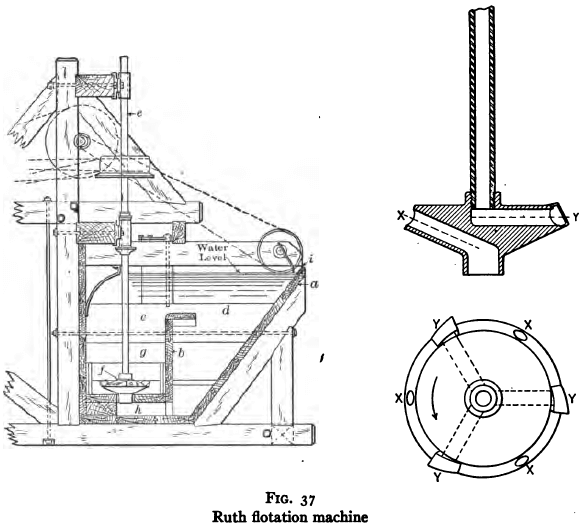
The Groch machine
It is the same in principle as the Ruth machine and differs from it only in the method of construction of the rotating disk and in the arrangement of the aerating compartment and spitzkasten.
The Hebbard sub-aeration machine
The machine is shown in Fig. 38. It consists essentially of a trough (A) partially sub-divided into compartments by partitions (c′) and (t), in which compartments are rotated vertical spindles (a) carrying at their lower end disks (b) with radial arms on the lower face. The machine pictured is known as a 24-in. machine, so denominated by the diameter of the disks. The trough (A) is 3 ft. wide, 24 ft. long, and 5 ft. deep, allowing 3 ft. by 3 ft. cross-sectional area for each 24-in. disk. Feed is introduced into the machine either through a feed pipe (e) from a pressure box (d), under the first disk, or it may be introduced by means of an ordinary feed box through a slot in the end wall. In the machine pictured, air under from two to five pounds pressure per square inch is supplied through the pipes (g) directly under each disk except the first. In machines fed through the end of the trough, air is also supplied under the first disk. Froth overflows the sides of the trough. Tailing is discharged through the slot (l) into the box (m). Pulp level is regulated by means of the valve in the discharge pipe (c). The capacity of a 24-in. machine is about 80 tons of sandy feed per compartment per 24 hours in a pulp containing 20 to 25 per cent. solids, with a power consumption of 10 h.p. per spindle. An 18-inch machine treats about 40 tons per cell with a power consumption of 6 1/2 to 7 h.p. per spindle. The air consumption is about 1/2 cu. ft. per minute per ton of daily capacity at a pressure of five pounds per square inch. The machine has been almost uniformly unsuccessful in the mills.
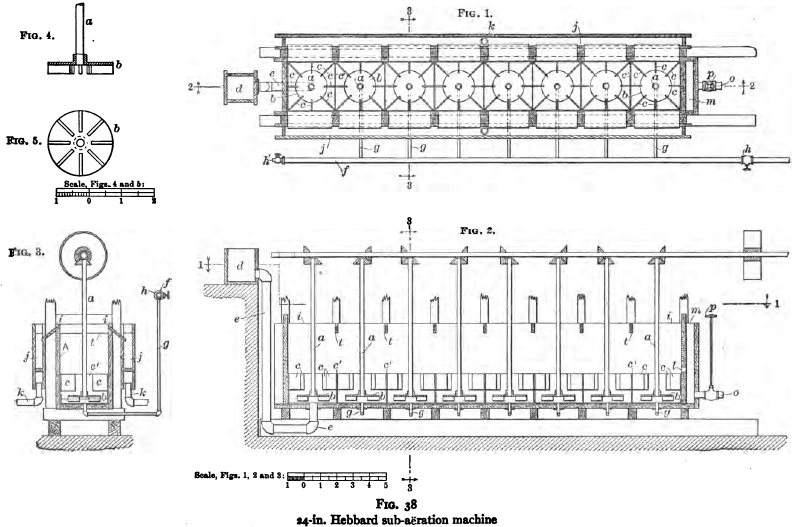
The Cascade machine
It utilizes the action of a stream of pulp plunging into a body of pulp to obtain the aeration necessary for flotation. The pulp fed to such a machine must be premixed with oil. One form of the machine is shown in Fig. 39. It consists of a sheet-iron tank with a cylindrical section about 6 ft. diameter by 1 ft. high and two conical sections of the same base attached thereto as shown. Pulp under a head of 3 to 4 ft. is discharged through the nozzle (b) within the perforated pipe (c) onto the surface of the pulp within this tank. The froth formed overflows the lip (e) and is carried off in the annular launder (f). Tailing is discharged through the pipe (g). Pulp level is regulated by a valve in this pipe. The dish-shaped casting (d) is designed to retard the flow of pulp through the machine. Machines are placed, several in series, with sufficient vertical distance between to give from 2 to 3 ft. head on the discharge nozzle (b) and a free fall of from 1 to 2 ft. from the nozzle to the surface of the pulp in the machine. These machines are not yet sufficiently standardized to allow a definite statement of capacities. A measure of capacity may, however, be obtained by allowing for an average rate of flow through the machine, equivalent to that through the froth-separating compartment of a Minerals Separation machine. The only power required is that sufficient to elevate the pulp. It is the writer’s opinion, however, that a sufficient number of successive treatments is necessary, in order to produce an economical recovery, to necessitate power in the elevation of pulp equal to that consumed in the other bubble-column machines.
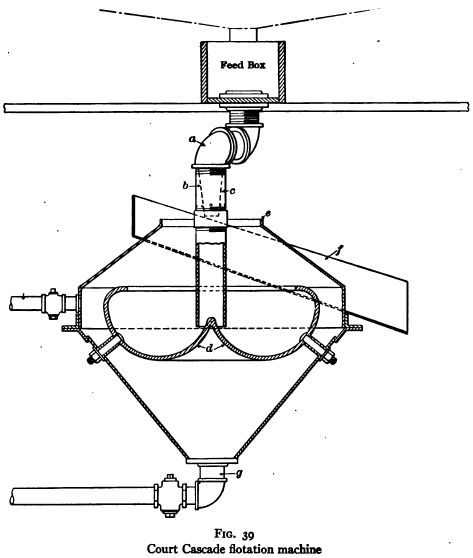

Combination Machines
Several mill flotation machines utilize combinations of the physical phenomena employed in the machines previously described, in order to produce flotation. The following are examples:
The Janney mechanical-air machine
The Janney mechanical-air machine utilizes pulp-body concentration and bubble-column concentration. The machine is shown, in Fig. 40. The combination is effected by placing air baskets in the froth-separating compartments of a Janney mechanical cell, at the same time reconstructing these compartments to accommodate the baskets. The agitating compartment is the same as that in the Janney mechanical machine with an individual vertical motor. The three-compartmented air baskets in each froth-separating compartment are supplied with air at from four to five pounds pressure on the supply side of the regulating valves. The machines are set up end-for-end as indicated in the drawing. The first machine in series is usually preceded by a Janney emulsifier. Pulp passes from the emulsifier discharge box, which may be taken as represented by box (a) in the drawing, through a pipe by gravity into the agitator compartment of the machine and is thrown up over the top of the agitator compartment onto the air baskets. Froth overflows the lips of the air-basket compartments. The tailing is in part circulated through the pipes (b) and finally passes through the adjustable overflow slots (c) into the tailings discharge launder (d) and thence to the following machine. By thus utilizing both methods of froth concentration, it is possible to make a good recovery in a relatively small number (five to six) of machines in series. The capacity of a 24-inch, five-compartment machine on silicious ore in a pulp containing 20 to 25 per cent, solids, is 150 to 200 tons per 24 hours. The power consumption per agitator is six to seven h.p. The air consumption per square foot of air basket is from 5 to 10 cu. ft. of free air per minute at four to five pounds pressure, corresponding to an additional power of five to eight h.p. per machine.
The K and K machine
The K and K machine, which is an improvement on the Rork machine, utilizes the principles of both the centrifugal-type and the cascade-type bubble- column machines. A diagrammatic sketch of the machine is presented in Fig. 41, taken from U. S. patent 1,174,737 to F. B. Kollberg and M. Kraut. The essential parts are an aerating compartment (1) and a froth-separating compartment (3). Aeration is accomplished by rapid revolution of the cylinder (17) which is about 30 in. diameter and 9 ft. long. Pulp is introduced at one end of the aerating compartment at a point somewhat above the shaft (16) and discharges through a pipe at the other end of the settling compartment. The pulp level is maintained well below the center of the shaft in the aerating compartment. Circulation of pulp within the machine is accomplished through the ports (11). Aeration is accomplished differently according to which of the cylinder surfaces, A, B, C, D, is used. When B and C are used air is carried into the pulp on the down coming side in the spaces between the cleats. This is essentially the action of the plunging stream in the Cascade machine. When type D is used there is, in addition to air thus carried into the pulp, a creation of vacua in the ports (21) into which air passes from the center of the cylinder. A similar combination of phenomena occurs in the use of A. The direction of rotation is as indicated by the arrow. Aerated pulp is thrown through the port (7) and introduced under the hood (8) over the baffle (9) below the surface of the pulp in (3). Froth overflows the lip of compartment (3). Air is allowed to enter through pipes (23) and water can be added through pipes (26).
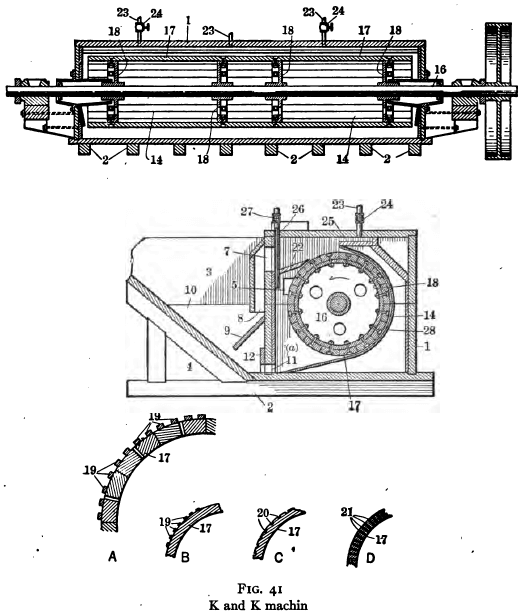
The first machine of this type was apparently that patented by C. E. Rork in 1915 (U. S. patent 1,136,485). This device had 12 arms bolted to a central shaft to form a typical paddle wheel. These arms did not extend the full length of the shaft but were broken to form a series of five or six paddle wheels on the same shaft, these wheels operating in compartments in a common box and each compartment was discharged into corresponding froth-separating compartments. Due to the considerable pressure exerted on this paddle shaft, both on account of the shape of the paddles and the structural features, the shaft bent so badly at high speeds that the device could not be used. In the present form, in which the paddle arms are at most 2 to 3 in. long in a radial direction and in which the paddles are multiplied to such an extent as to form practically a continuous cylinder, the resistance offered by the pulp is materially lessened and the rotating part offers much more resistance to deflection.
The K and K machine is ordinarily driven at from 180 to 200 r.p.m. The capacity varies from 50 to 100 tons per 24 hours with a power consumption of from 5 to 10 h.p. according to the volume of pulp passed.
Comparison of Machines
The Janney machine is the best of the agitation-type machines, both structurally and from the point of view of metallurgical results. It will probably return sufficiently more metal as compared with the Minerals Separation machine to more than pay for the additional first cost and for any additional power consumption per ton of ore treated. Machines of the modified Callow type such as the Miami and Inspiration are more economical of floor space than those of the typical Callow type and will also be cheaper in first cost, if the tonnage to be treated is sufficient to warrant their use. Metallurgical results in both classes of machines will be about the same. It is probable that the highest possible metallurgical results can be obtained in the Janney mechanical-air machine, but at an expenditure of power which is unwarranted in most cases. Machines of the K and K type are attractive from the point of view of low power consumption but they are not economical of floor space in case of large installations, and are subject to considerable mechanical difficulties. It is significant that in several cases these machines have been displaced, after trial, by machines of other types, in spite of the lower power consumption. Machines of the pneumatic variety show a lower upkeep and a lower cost of operation over considerable periods of time than do machines of the agitation type. It is the writer’s opinion that ten years’ time will see the agitation-type machine almost completely displaced by machines of the pneumatic type. The Hebbard sub- aeration machine has given much trouble mechanically and has been thrown out of many mills after trial on this account. The Ruth and Groch machines have not been given enough trial to warrant general statements as to their usefulness. Much is claimed for machines of the Cascade type but, notwithstanding their trial at many of the larger mills in the country, no installations of any size have been made. Installations of this machine will be awkward from the point of view of mill construction and operation. Oil-flotation machines are nowhere in use today and skin-flotation machines are used in but few places. As previously stated, the use of the latter type of machine is justified only where a high-grade concentrate must be made, irrespective of the grade of the tailing.
Taggart P 161-198
